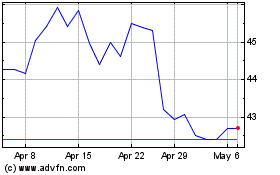SYDNEY—When South32 Ltd., the mining company spun out of BHP
Billiton Ltd., launched in May, its backers claimed its low debt
and focus on a clutch of commodities would help it weather any
stormy markets ahead.
Five months after one of the biggest breakups in corporate
mining history, those claims are already in doubt.
South32's stock has been in free fall as prices for its
products, including aluminum and coal, have fallen into a deep
slump. Last week, its shares dropped to a fresh nadir of 1.33
Australian dollars (US$0.96).
Despite a modest recovery this week, South32 is still down
nearly 30% since it listed. A company some touted as being worth as
much as US$15 billion before its launch now has a market value of
just more than US$6 billion.
South32 is doing worse than its peers amid this year's
broad-based commodities selloff. The company—listed in Sydney,
Johannesburg and London—has underperformed an index of Australia's
top resources companies, which is down roughly 15% since South32's
debut in May. Shares in its former parent, BHP, are down 16% over
the same period.
"One wouldn't classify it as a raging success," said Anthony
Sedgwick, a fund manager and co-founder at South Africa-based Abax
Investments Pty. Ltd., which has nevertheless kept a small holding
in South32 since its demerger.
The question now is whether South32's rocky start is a result of
bad timing, or if its problems run deeper.
In theory, corporate spinoffs create value by unleashing the
potential of business lines that may have been hidden within large
corporations. In South32's case, operations such as nickel and
manganese mining that were too small to make a difference to BHP's
profits were expected to blossom. That, in turn, was supposed to
benefit BHP investors, who received one share in the new company
for every share they owned in the mining giant.
Some saw flaws from the start. A key concern has been South32's
heavy reliance on operations in South Africa, where it runs coal
and manganese mines and an aluminum smelter. Resources companies
there have long grappled with issues such as frequent worker
strikes and surging electricity costs.
"Before the company listed, a lot of people were talking about
how spinoffs tend to outperform parent companies—but with South32,
we just didn't think that would be the case," said one London-based
fund manager who sold off his stake soon after the new company's
debut.
South32's cost-cutting efforts have also failed to keep pace
with collapsing prices—or market expectations, according to
analysts at Goldman Sachs, who describe its management's goals as
"uninspiring."
The miner reported a net loss of $919 million in its maiden
full-year fiscal report in August.
After the recent slide in commodity prices some of South32's
major operations, including its Cerro Matoso nickel mine in
Colombia and its South African manganese business, are now
unprofitable, according to Australian bank Macquarie Group. The
bank argues that the company should cut back production in such
places. South32 has already cut output at its Metalloys manganese
alloy smelter in South Africa and Alumar aluminum smelter in
Brazil, two operations it runs in joint venture with other
companies.
"The business looks rather challenged," said Ivor Pether, a fund
manager at U.K.-based Royal London Asset Management, who said he
"exited early."
Luck hasn't favored South32. Prices for manganese and
nickel—which together account for one-quarter of its underlying
earnings—as well as zinc have been the most volatile among major
commodities in recent times, Goldman said. That volatility
continued Friday after Glencore PLC said it would cut global zinc
production by a third, sending prices of the metal sharply
higher.
"We are hugely exposed to foreign-exchange and commodity
prices," South32 Chief Executive Graham Kerr said in a recent
interview.
Others say South32's modest ambitions could yet prove a
strength. Unlike many other mining companies, the company hasn't
borrowed excessively to fund massive investments or acquisitions.
Its net debt is equivalent to just 4% of its total capital, a very
low ratio by industry standards.
The company "has never been nor ever tried to sell itself as a
sexy story" of surging output or massive new projects, said Abax's
Mr. Sedgwick. "The attraction is that it is a pretty dull and
boring portfolio of assets."
For BHP at least, the spinoff appears to have worked. It has
benefited from unloading assets that were previously mere footnotes
for the group: Had it retained South32's poorly performing
businesses, the recent slide in BHP's shares could have been
deeper. In August, BHP said it had achieved its goal of cutting
annual costs by $4 billion two years ahead of schedule. It earlier
projected that carving out South32 would help it surpass that
target.
As for South32, one possibility is that it has now become cheap
enough to be an acquisition target. Analysts say one potential
buyer is X2 Resources, an investment fund founded by Mick Davis.
Some think the company could even look to acquire itself. "With
South32's global peers hamstrung by large debt levels, the company
has the opportunity to look to invest in growth at a period when
others do not," Goldman's analysts said.
Big spending doesn't seem to be Mr. Kerr's priority for now.
"Our job in the next 12 months is to deliver—nothing is going to
speak like actions," he said.
Write to Rhiannon Hoyle at rhiannon.hoyle@wsj.com and Alex
MacDonald at alex.macdonald@wsj.com
Subscribe to WSJ: http://online.wsj.com?mod=djnwires
(END) Dow Jones Newswires
October 09, 2015 04:45 ET (08:45 GMT)
Copyright (c) 2015 Dow Jones & Company, Inc.
BHP (ASX:BHP)
Historical Stock Chart
From Mar 2024 to Apr 2024

BHP (ASX:BHP)
Historical Stock Chart
From Apr 2023 to Apr 2024
